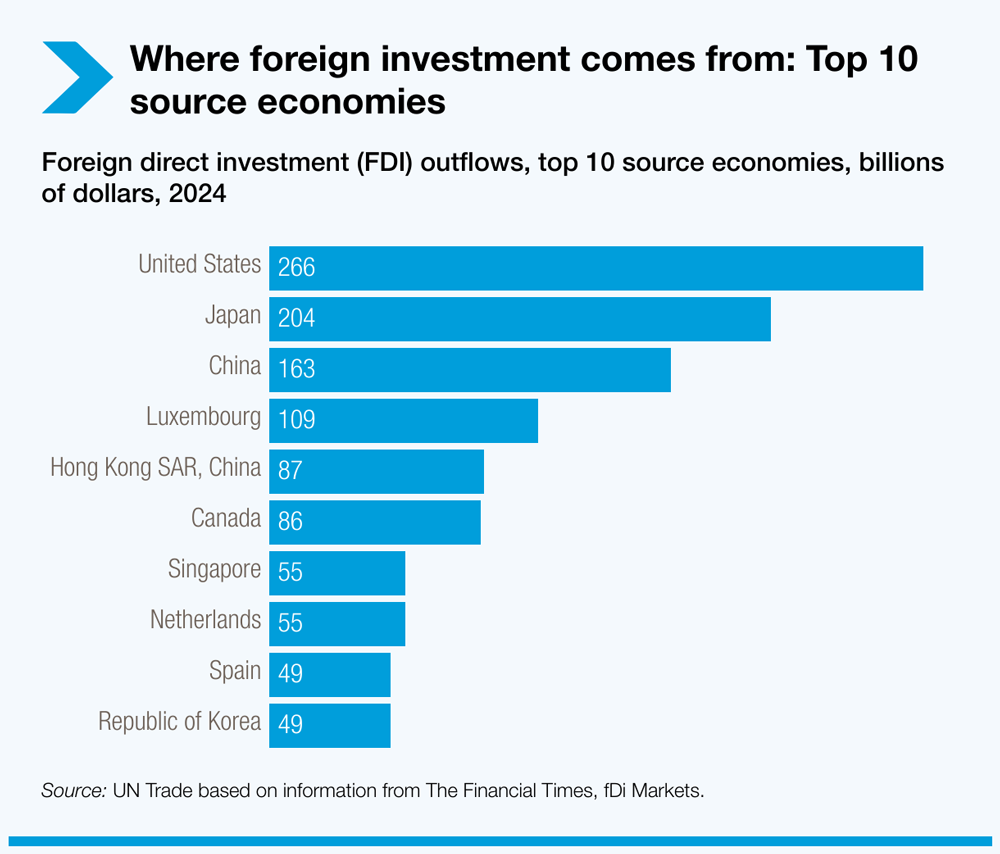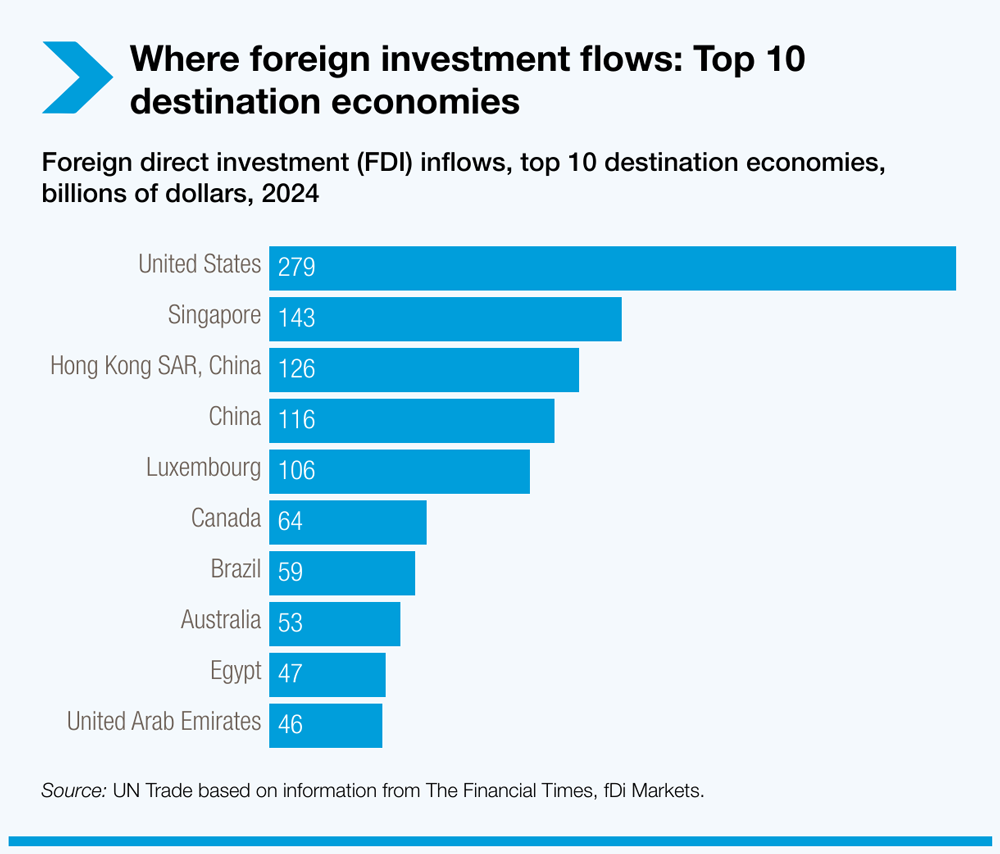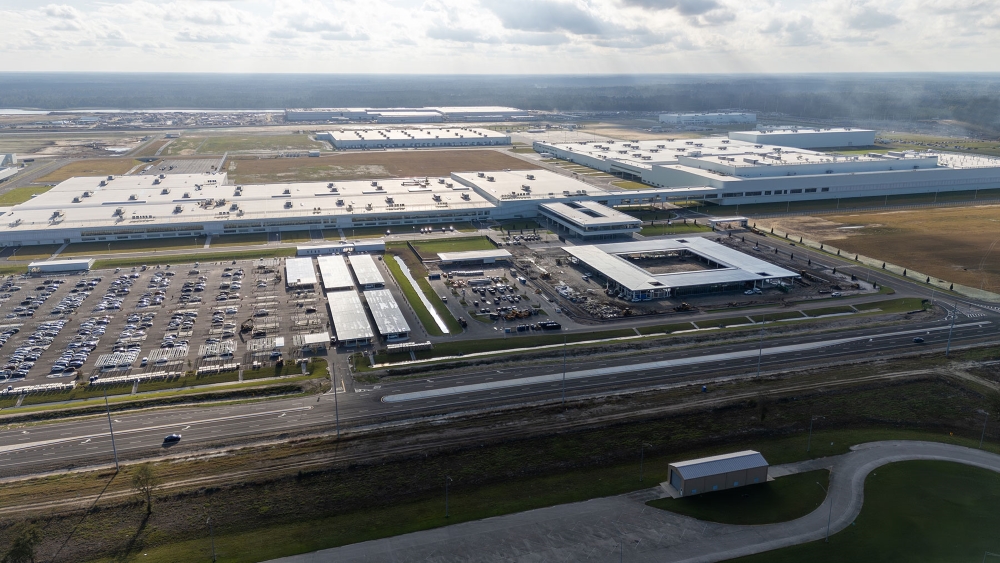Foreign investment in the States continues to roll in as trade temperatures fluctuate.
Foreign dollars invested in the United States increased by $332.1 billion to $5.71 trillion at the end of 2024, with the manufacturing sector seeing the highest increases and retaining the largest sector of foreign direct investment (FDI) in the country. This year has also seen a yo-yo effect when it comes to foreign investment, with a disappointing first quarter followed by a rebound in the second financial quarter of the year, showing over $100 billion in preliminary FDI recorded in Q2 of 2025, per the U.S. Bureau of Economic Analysis.
UN Trade & Investment (UNCTAD) released its FDI Explorer in early October, tracking global investment flows. The U.S. continues to be the top economy in both inward and outward FDI, with $266 billion invested outside of the country; Japan and China’s FDI investments in other countries totaled $204 billion and $163 billion, respectively. The U.S., Singapore and Hong Kong were the top three economies receiving FDI ($279 billion, $143 billion and $126 billion, respectively), with the U.S — aided by semiconductor megaprojects — helping North America see an increase of 23% in FDI projects.
One expert says there’s room for plenty more. Asked how FDI can aid the American economy, Harry Moser, founder and president of the Reshoring Initiative, says, “There are hundreds of places, especially the supply chain gaps in which most of the market demand for a product is supplied from offshore, e.g., electronic assembly, rare earth minerals, tool steel, contract manufacturer doing complex assemblies, carbide, etc.”
Projects, Projects Everywhere
According to a 2025 SelectUSA report on FDI trends in U.S. manufacturing sectors, with data provided by Moody’s Solutions and IBM-Plant Location International, manufacturing has consistently attracted significant FDI over the past 10 years and has been one of the largest recipient sectors of foreign investment in the country; from 2014 to 2024, there have been 4,031 FDI projects announced and completed in U.S. manufacturing, with $826 billion in capital expenditure and more than 667,000 jobs created.


Source: UN Trade/Financial Times, fDiMarkets
Japan continues to lead FDI in U.S. manufacturing, focusing on automotive and electronics. Germany, Canada, the UK and France are also all top source markets for FDI projects in American manufacturing. The last three years saw capex growth of 23% on average, signaling a future trend toward larger or capital-intensive projects.
Tracking U.S. investment projects of foreign origin in Site Selection’s Conway Data Projects Database from January 1, 2024, to September 30, 2025, shows Canada, the UK, Germany, Japan and Switzerland to be the top countries of origin in that order. Projects qualify to be in the database if they involve facility construction/expansion and involve at least $1 million invested, 20 new jobs created or 20,000 new sq. ft. of space.
The five top-performing sectors in the report included machinery, equipment and construction; transport and logistics; electronics; business and financial services and the life sciences. Texas led as the top state by number of FDI projects; North Carolina, Illinois, California, New York, Georgia, Ohio, Florida, South Carolina and Pennsylvania round out the top 10.
The Palmetto State and leading investor country Japan came together in October when Isuzu North America Corporation broke ground on a 1-million-sq.-ft. production facility in Piedmont, South Carolina.
“We worked with a site selection consultant who helped us evaluate both greenfield and brownfield opportunities across several states,” Noboru Murakami, chairman & CEO of Isuzu North America Corporation, tells Site Selection. “Ultimately, we found the right combination of site, facility and business climate in Greenville County. The region offers a deep automotive talent base, access to the Port of Charleston and excellent infrastructure. We were also able to secure strong economic development support from both the State and Greenville County.”
Murakami also notes that the North American truck market is a key driver of Isuzu’s global growth strategy. To sustain growth in North America, the company recognized the need to significantly expand its U.S. presence.
“Our new production plant is just one part of that commitment,” Murakami says. “We are also increasing our sourcing from domestic suppliers and expanding our advanced automotive technology research and development activities in the United States.”
Uncertain Times
Despite optimistic numbers in the North American market, FDI in the U.S. is subject to more ups and downs due to a few wrenches thrown into that economic engine. In September a controversial immigration bust at a Hyundai/LG EV battery plant located in Ellabell in southern Georgia appeared to fray business relationships between the U.S. and South Korea and potentially other Asia-based investors. In a LinkedIn post shortly after the ICE raid took place in Ellabell, Didi Caldwell, president and CEO of Global Location Strategies and chair of the board of REDI Sites, weighed in on its potential impact on FDI in the States.
“On one hand, the U.S. is eager to attract this investment,” Caldwell said. “On the other hand, its own enforcement actions risk undermining it. […] With clear visa categories for specialized workers, more transparent enforcement and open communication between governments, we can restore the confidence foreign investors need. If we get this right, the U.S can remain the premier destination for advanced manufacturing. And American workers and global companies will benefit.”
The Hyundai/LG Battery metaplant has cost $12 billion to build so far, is touted as the largest FDI project in Georgia and is set to produce 500,000 EVs annually along with EV batteries once complete. As of October 2024, the plant employed over 1,400 individuals. Following the raid, which resulted in 450 workers from South Korea being detained (and then swiftly recalled back to their home country by the South Korean government), Hyundai announced its intent to invest another $2.7 billion at the Ellabell site and employ an additional 7,000 workers, standing firm on its investment.
Georgia Governor Brian Kemp, who has publicly supported enforcement of U.S. immigration policies since his first campaign for state governor, has been a staunch advocate for the Hyundai/LG project in Georgia, which has received $1.8 billion in taxpayer-subsidized incentives from local and state governments. In a statement from his office a week after the ICE raid in Ellabell, Kemp said that “Georgia has always worked to maintain a strong relationship with the Republic of Korea and Korean partners like Hyundai, stretching back 40 years to the establishment of Georgia’s trade office in Seoul.”
The EV battery plant will experience a few months’ delay, and Hyundai has announced its desire to have the worker visa process revisited. This may be a tough thing to negotiate as work visas have also come under fire in the U.S. when the Trump Administration announced in September 2025 a price hike on new H-1B visas from a few grand to a cool $100,000 each.
To H-1B or Not To H-1B
The recent H-1B policy change by the Trump Administration is expected to impact the tech sector the hardest as the majority of H-1B visa holders typically have education and experience in the IT/STEM fields and work in the computer industry (~65%). Big tech dominates the leaderboard when it comes to hiring the most H-1B visa holders (Amazon, Google, Microsoft, Apple, Meta, IBM). Amazon alone receives nearly 3% of all H-1B approvals (the highest in the country for any company) and hired over 10,000 foreign workers in fiscal year 2025. In 2024, over 440,000 H-1B visas were approved, with about 258,000 of those comprising renewed visas.
CEO Jensen Huang of Nvidia indicated in early October the company’s intent to continue sponsoring H-1B workers and cover all fees tied to this process. But most companies and organizations impacted by this visa policy change do not have the deep coffers that Nvidia has.

The Hyundai metaplant’s first vehicle produced was a 2025 IONIQ 5, and the second will be a 2026 IONIQ 9. The Ellabell facility will eventually produce models for Kia and Genesis, which are owned by Hyundai. Photo courtesy of Hyundai
“The proposed additional $100,000 fee will dissuade most companies from sponsoring someone for the visa. It is just too time-consuming and costly,” says Caldwell. “Even before the additional fee, it can cost tens of thousands of dollars and take more than a year. Employers have to validate that they cannot find someone domestically that can meet the requirements of the job. So, if it is too expensive for small companies to sponsor a prospective employee, they either hire someone who is not qualified, or the job goes unfilled. Either way, the company’s ability to compete in the global arena is reduced. When you consider the thousands of U.S. companies who will be impacted, that has an outsized effect on the U.S. economy in the short and long term.

“Companies recruit talent globally,” Caldwell says. “If they are not able to employ global talent in the U.S., research, development and innovation will be shifted to countries like Canada, the UK, parts of Europe and Singapore where the infrastructure exists and companies can access the talent they require. The U.S. in the past has been a magnet for top talent. With the new policies, we may witness a global redistribution of skilled workers.”
The effects of the cost increase on new H-1B visas will also almost certainly have an impact on the manufacturing industry, where highly skilled workers of foreign nationality are often hired to work on specialized equipment and construction processes on sites built in the U.S. by foreign companies.
“This issue is particularly consequential and runs counter to the policy goal of restoring manufacturing in the United States,” says Carl Quesinberry, senior director at Avison Young Industrial Corporate Services. “Many of these projects rely on highly specialized production equipment sourced from international manufacturers, often ordered more than a year in advance and only recently delivered. The skilled labor required to install and commission this equipment typically comes from the same countries of origin, making visa access indispensable. Restricting this process will drive up costs, extend project timelines and create a barrier to both FDI and domestic expansion opportunities. The process of installation and commissioning can take over a year. The U.S. policy should also embrace that these required temporary workers have their families accompany them.
“Compounding this challenge, long-lead production equipment ordered prior to recent changes in tariff policy is now being assessed under the revised tariff structure,” Quesinberry says. “This means companies are bearing costs that were neither anticipated nor budgeted under the prior framework. The result is a counterintuitive outcome: Rather than incentivizing and accelerating U.S. manufacturing investment, these policies risk undermining it.”
The H-1B visa program began in 1990 and operates as a talent pipeline for highly skilled foreign workers to work in the U.S. on a temporary basis with the possibility of extension and/or permanent residency if the visa holder receives green card sponsorship. According to the Pew Research Center, most H-1B visa holders are from India (~70%) and China (12%), and in 2021 over half of H-1B holders held a master’s degree (57%). To qualify for a H-1B visa, one must hold at least a bachelor’s degree.
FDI: Asked & Answered
In this Q&A, Jonathan Samford, president and CEO of the Global Business Alliance, offers insight on the direction of foreign investment in the United States and what site selectors are considering when making decisions to sign on the dotted line.

What are some key factors that site selectors look at when considering locations for FDI?
Jonathan Samford: Proximity to customers is consistently the most important factor when companies are deciding where to expand. Between similar locations, however, large employers evaluate their ready access to a high-skilled workforce and the predictability of the jurisdiction’s regulatory and policy landscape.
Do you have any recommendations to companies who are considering bringing their business to the States?
Samford: The U.S. continues to be a welcoming environment where international companies can find long-term success. But perhaps more so than in the past, investors should keep a close eye on policymaking to differentiate policy cues from political clatter.
How are companies managing differences in culture and operations when it comes to the integration of foreign investments in the U.S.?
Samford: International companies strengthen every corner of the U.S. economy. They not only bring the capital they need to grow, but they also import world-class know-how, which benefits the millions of Americans they employ. Overwhelmingly, international companies depend on American workers to succeed. And workers at international companies typically earn 7% higher wages and benefits than the economy-wide average. That’s a win-win situation.
How does FDI improve the communities that are being invested in?
Samford: Global investment delivers real impact: good-paying jobs, resources for innovation, world-class workforce development and a strong commitment to be part of the communities where they operate. That’s why policymakers from hometown mayors to the President of the United States are actively encouraging international companies to invest and create jobs here.
What are some trends you have noticed when it comes to FDI projects in the U.S. in the past few years, and how have they informed operations at your organization?
Samford: Over the past decade, more of the FDI flowing into the United States is coming from reinvested earnings, where a company pours its profits back into its U.S. operations. It’s a sign that existing investors remain bullish, while would-be investors have hit pause on their investments. Representing some of the most well-known brands in the world, our focus is on making sure U.S. policymakers don’t take these companies for granted — or worse, try to extract concessions from other nations by making them political collateral. America benefits when international companies invest here.
How have policies from the current presidential administration impacted FDI projects in the U.S.?
Samford: It’s clear that companies value the certainty that the recently announced trade agreements have provided. Investment in the second quarter surged by 137% over the previous period. President Trump has made it clear that he wants more international companies to invest in America. His “America First Investment Policy,” the Investment Accelerator, the One Big Beautiful Bill Act, lower energy costs and regulatory cuts incentivize global firms to grow their U.S. operations.
Which sectors are foreign investments primarily going toward in the U.S.?
Samford: Manufacturing leads the way. Thanks to international companies, nearly 3 million Americans are making things right here at home. Investment in this sector makes up 42% of all global investment in the U.S.
Are there areas or sectors in the U.S. that are being left behind by foreign business interests?
Samford: Some industries, like banking and real estate, aren’t seeing the same level of growth as others.
How is the recent U.S. immigration enforcement at the Hyundai plant in southern Georgia affecting investment decisions in America by foreign companies?
Samford: More than 8 million Americans are employed by companies that made a deliberate decision to invest and create jobs in the United States. I’m unaware of any company that has changed its investment strategy in light of the administration’s immigration policy.
“Proximity to customers is consistently the most important factor when companies are deciding where to expand.”
— Jonathan Samford, President & CEO, Global Business Alliance
The White House indicated there would be a $100,000 fee for those seeking H-1B visas. What impact do you see this policy having on workforce development and interest from foreign companies seeking to make FDI choices in the U.S.?
Samford: Again, the vast majority of international companies employ American workers. In fact, 2.8 million U.S. manufacturing workers are employed at one of these companies, and today, 12% of America’s private-sector research and development is conducted by American scientists at international companies.
Currently, what are the main risks non-U.S. companies are considering when making investments in the States?
Samford: At the end of the day, investors want stability and predictability so they can grow with confidence. While President Trump is clearly renegotiating our trading relationships with other nations, his administration remains supportive of welcoming international companies that are interested in investing and creating jobs in the United States. Not participating in America’s dynamic, innovative economy may be the biggest risk facing would-be investors, followed by not having sufficient resources to help explain and understand the administration’s actions.

